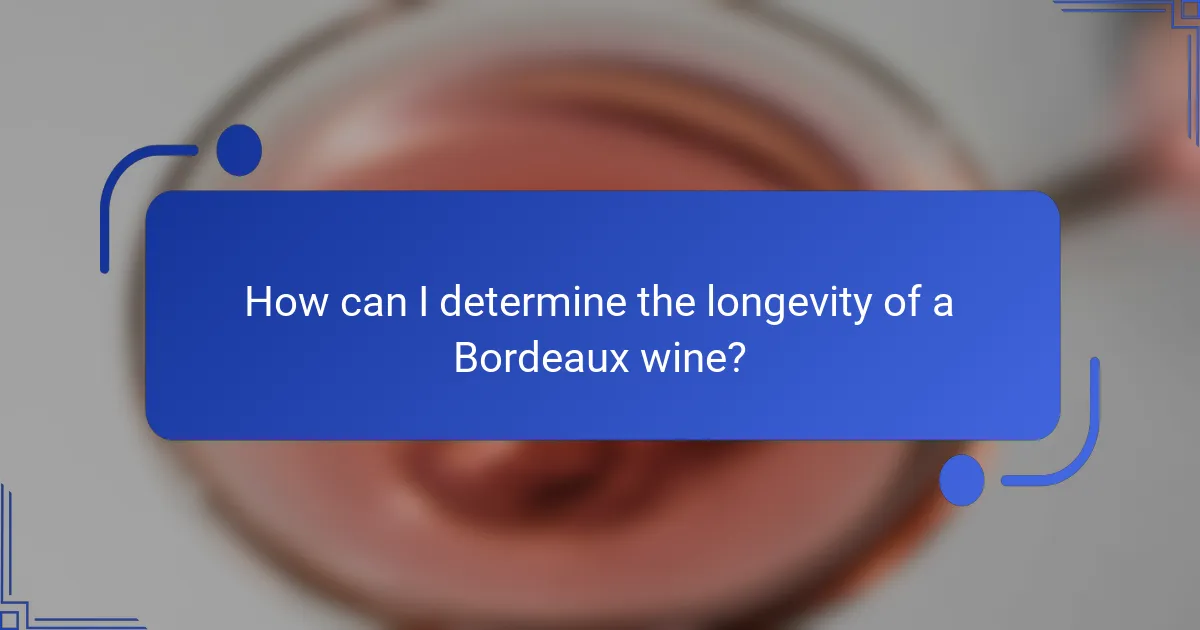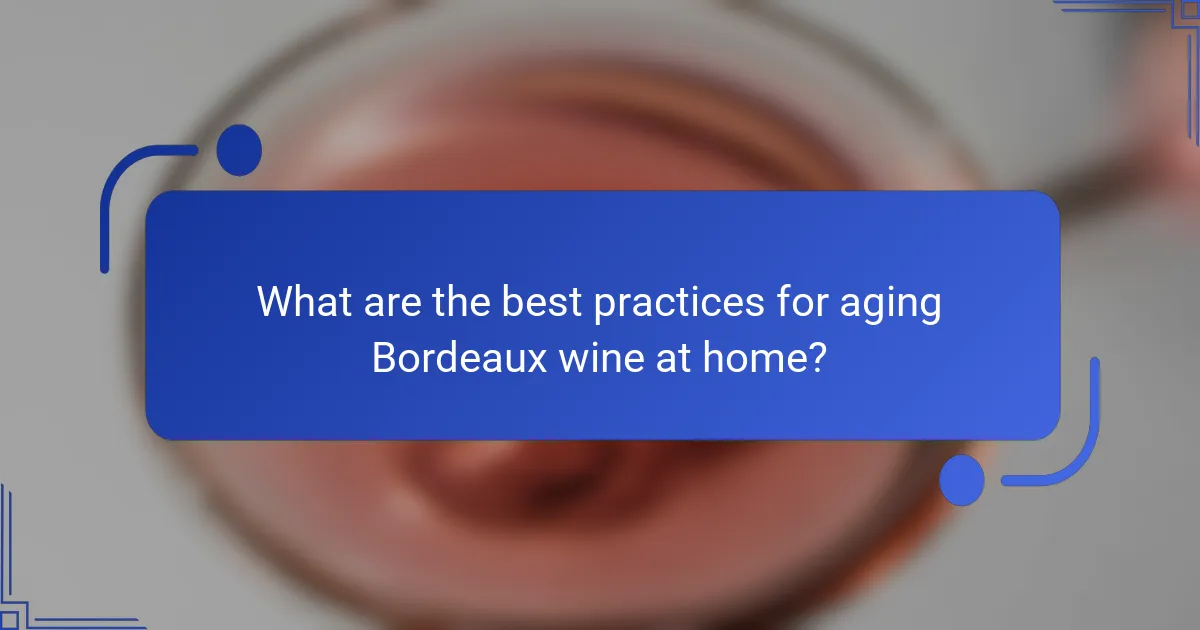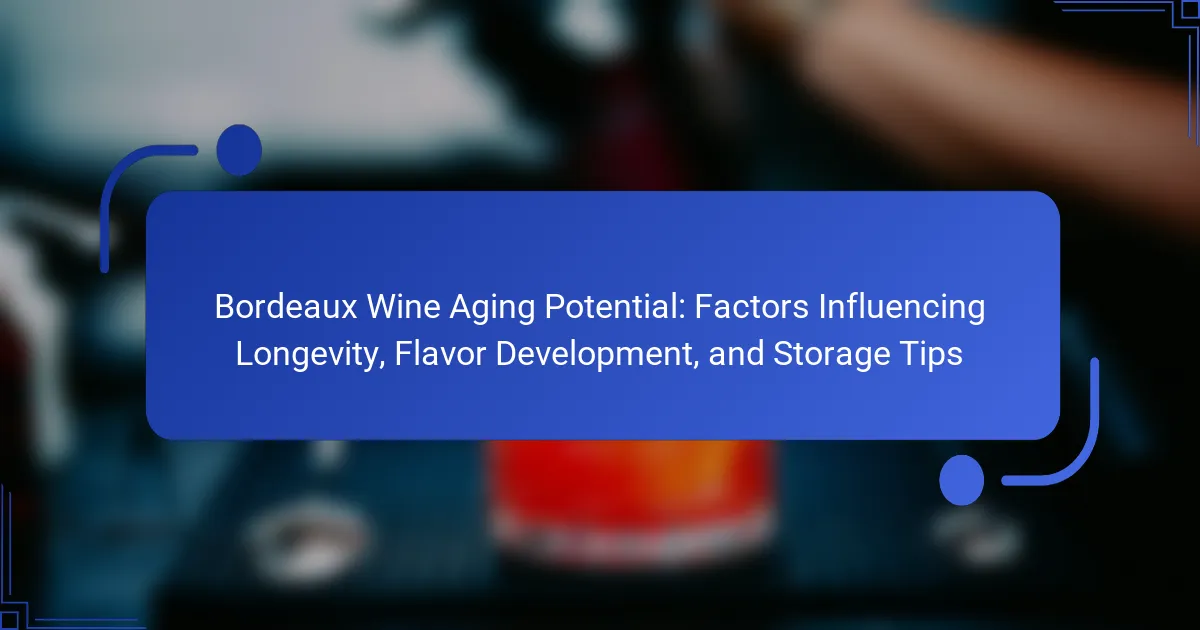
What is Bordeaux Wine Aging Potential?
Bordeaux wine aging potential refers to the ability of Bordeaux wines to improve in quality over time. This potential varies based on factors such as grape variety, tannin structure, and acidity. Bordeaux wines, particularly those from classified growths, can age for decades. For example, top vintages of Cabernet Sauvignon can mature for 20 to 30 years or more. The aging process enhances flavors and complexity, developing notes like leather, tobacco, and earthy undertones. Wines with high tannin levels and balanced acidity typically show better aging potential. Studies indicate that proper storage conditions significantly influence aging outcomes. Ideal conditions include stable temperatures, humidity control, and minimal light exposure.
How does aging affect Bordeaux wine?
Aging enhances Bordeaux wine by developing its flavors and aromas. Over time, tannins soften, leading to a smoother mouthfeel. The wine’s fruit flavors evolve into more complex notes such as leather, tobacco, and spices. Oxygen interacts with the wine, promoting chemical reactions that contribute to its maturation. This aging process can last from a few years to several decades, depending on the wine’s quality and structure. Bordeaux wines, particularly those from reputable vintages, often benefit from extended aging. Studies indicate that well-aged Bordeaux can reach peak complexity and balance after 10 to 20 years. This transformation is influenced by factors like grape variety, vineyard practices, and storage conditions.
What chemical processes occur during the aging of Bordeaux wine?
During the aging of Bordeaux wine, several chemical processes occur that significantly affect its flavor and quality. Oxidation is a primary process where oxygen interacts with phenolic compounds, leading to the development of complex flavors. Tannins polymerize over time, softening the wine’s texture and contributing to its mouthfeel. Esterification occurs as acids and alcohols react, forming esters that enhance the wine’s aromatic profile. Additionally, the wine undergoes microbial activity, including malolactic fermentation, which converts sharp malic acid into softer lactic acid, further smoothing the taste. These processes collectively contribute to the evolution of Bordeaux wine, enhancing its depth and complexity as it matures.
How does aging influence the flavor profile of Bordeaux wine?
Aging significantly influences the flavor profile of Bordeaux wine. Over time, chemical reactions occur within the wine, leading to the development of complex flavors. Tannins soften, resulting in a smoother mouthfeel. Fruit flavors evolve, often transitioning from fresh to dried or jammy notes. Secondary flavors, such as leather, tobacco, and earthiness, emerge with age. The aging process also enhances aromas, adding layers of complexity. Bordeaux wines typically benefit from aging due to their high acidity and tannin levels. Studies show that wines aged for 10 to 20 years can develop significantly richer profiles. This evolution is particularly evident in renowned Bordeaux vintages, which are celebrated for their depth and complexity.
What factors influence the aging potential of Bordeaux wine?
The aging potential of Bordeaux wine is influenced by several key factors. These include the wine’s acidity, tannin structure, and sugar content. High acidity helps preserve the wine over time. Tannins, derived from grape skins and seeds, contribute to the wine’s structure and longevity. A balanced level of sugar can also enhance aging potential. The grape variety plays a significant role; for example, Cabernet Sauvignon typically ages better than Merlot. Additionally, the wine’s storage conditions, such as temperature and humidity, affect its aging process. Proper storage minimizes oxidation and spoilage, allowing the wine to develop complex flavors. Historical vintages, such as those from 1982 and 2000, demonstrate how these factors contribute to the wine’s longevity and flavor evolution.
How do grape variety and composition impact aging potential?
Grape variety and composition significantly impact aging potential in wine. Different grape varieties possess unique characteristics that influence their longevity. For instance, Cabernet Sauvignon is known for its high tannin content, which contributes to its ability to age well. Tannins act as natural preservatives, helping the wine evolve over time.
Additionally, the acidity level in grape composition affects aging. Higher acidity can enhance a wine’s aging potential by maintaining freshness and balance. For example, wines made from grapes like Merlot often have lower acidity, which may limit their aging capability compared to more acidic varieties.
The phenolic compounds present in grapes also play a crucial role. These compounds contribute to color, flavor, and mouthfeel. Wines with a rich phenolic profile, such as those from Bordeaux blends, tend to age better. They develop complexity and depth as they mature.
In summary, grape variety and composition directly influence the aging potential of wine through tannin levels, acidity, and phenolic compounds.
What role does the terroir play in Bordeaux wine aging?
Terroir significantly influences Bordeaux wine aging. It encompasses the unique combination of soil, climate, and topography. The diverse soils of Bordeaux, such as clay and gravel, affect drainage and nutrient availability. This, in turn, impacts vine health and grape maturity. Climate conditions, including temperature and rainfall, influence the ripening process. These factors contribute to the wine’s flavor profile and aging potential. Studies show that wines from specific terroirs can develop complex flavors over time. For example, wines from the Médoc region often age well due to their unique terroir characteristics. Thus, terroir plays a crucial role in determining the longevity and quality of Bordeaux wines during aging.
How does the winemaking process affect aging potential?
The winemaking process significantly influences the aging potential of Bordeaux wine. Key factors include grape selection, fermentation methods, and aging techniques. High-quality grapes contribute to better structure and acidity. Fermentation at controlled temperatures preserves flavors and aromas. The use of oak barrels during aging adds complexity and tannins. Tannins are essential for longevity, as they help stabilize the wine over time. Additionally, malolactic fermentation softens acidity, enhancing mouthfeel and aging capacity. Studies show that wines with higher acidity and tannin levels age better. Therefore, winemaking practices directly impact the wine’s ability to mature and develop over years.
Why is storage important for Bordeaux wine aging?
Storage is crucial for Bordeaux wine aging because it directly affects the wine’s quality and development. Proper storage conditions maintain consistent temperature and humidity levels. Bordeaux wines typically age best at temperatures between 50°F and 55°F. Fluctuations can lead to premature aging or spoilage. Additionally, humidity levels should be around 70% to prevent cork drying. A dry cork can allow oxygen to enter the bottle, spoiling the wine. Light exposure can also degrade the wine, making dark storage environments preferable. Finally, vibrations can disturb sediment and affect the aging process. Therefore, optimal storage conditions are essential for preserving and enhancing the characteristics of Bordeaux wine over time.
What are the ideal storage conditions for Bordeaux wine?
Bordeaux wine should be stored in a dark, cool environment. The ideal temperature range is between 50°F and 59°F (10°C to 15°C). Humidity levels should be maintained between 60% and 75% to prevent cork drying. Bordeaux wine should be stored horizontally to keep the cork moist. Vibration should be minimized to prevent disturbance of sediment. Avoid storing wine near strong odors or direct sunlight. These conditions help preserve the wine’s flavor and aging potential.
How does temperature affect the aging process of Bordeaux wine?
Temperature significantly influences the aging process of Bordeaux wine. Higher temperatures accelerate chemical reactions, leading to faster aging. This can result in the premature development of flavors and aromas. Conversely, lower temperatures slow down the aging process. This can preserve the wine’s freshness and complexity for a longer duration. Ideal aging temperatures range from 50°F to 55°F (10°C to 13°C). Fluctuations in temperature can also negatively impact the wine. They may cause cork expansion and contraction, leading to oxidation. Consistent storage conditions are essential for optimal aging.

How can I determine the longevity of a Bordeaux wine?
To determine the longevity of a Bordeaux wine, evaluate its vintage, grape variety, and storage conditions. Bordeaux wines from renowned vintages, like 2000 or 2005, tend to age better. The grape varieties also play a crucial role; Cabernet Sauvignon generally has a longer aging potential than Merlot. Additionally, proper storage conditions, such as consistent temperature and humidity, can significantly impact longevity. Wines stored in optimal conditions can often last several decades. For instance, top Bordeaux wines can age from 10 to 50 years, depending on these factors.
What indicators can suggest a Bordeaux wine’s aging potential?
Indicators that suggest a Bordeaux wine’s aging potential include tannin levels, acidity, alcohol content, and fruit concentration. High tannin levels contribute to the structure and longevity of the wine. Acidity helps preserve the wine over time, enhancing its freshness. A higher alcohol content can also indicate better aging potential, as it often correlates with the wine’s body and richness. Additionally, concentrated fruit flavors are essential; they provide the core around which the wine develops complexity with age. Bordeaux wines from reputable vintages and regions, such as Médoc or Saint-Émilion, are often designed for aging. Historical data shows that wines from these areas can improve significantly over decades, validating these indicators.
How do tannins and acidity contribute to a wine’s longevity?
Tannins and acidity are crucial for a wine’s longevity. Tannins act as natural preservatives. They help protect wine from oxidation. High tannin levels can enhance the aging potential of red wines. Acidity contributes by balancing flavors and preventing spoilage. Wines with higher acidity tend to age better. They maintain freshness over time. Studies show that wines with both high tannins and acidity develop complex flavors as they age. This combination is often seen in Bordeaux wines, which are known for their aging potential.
What are the signs of a Bordeaux wine that is ready to drink?
A Bordeaux wine that is ready to drink typically shows a clear, vibrant color. The hue should be deep red for young wines and may shift to garnet or brick for older vintages. Aromas should be well-developed, featuring notes of fruit, spice, and earth. The palate should display balanced acidity and tannins, indicating maturity. A smooth mouthfeel is a sign that the wine has aged properly. Additionally, the wine should have a lingering finish, suggesting complexity. These characteristics indicate that the wine has reached its optimal drinking window.
How does vintage affect the aging potential of Bordeaux wine?
Vintage significantly influences the aging potential of Bordeaux wine. The vintage reflects the specific climate conditions during the growing season. Favorable weather leads to optimal grape ripeness and balanced acidity. These factors enhance the wine’s structure and longevity. Historical data shows that exceptional vintages, such as 2000 and 2005, are known for their aging capabilities. In contrast, poor vintages often result in wines that do not age as well. The vintage also affects tannin development, which is crucial for aging. Higher tannin levels typically indicate better aging potential. Thus, the vintage serves as a key indicator of a Bordeaux wine’s capacity to mature over time.
What are the characteristics of exceptional Bordeaux vintages?
Exceptional Bordeaux vintages are characterized by a combination of climate, terroir, and winemaking practices. These vintages often experience optimal weather conditions, such as a warm growing season followed by a dry harvest period. The terroir, which includes soil composition and drainage, plays a critical role in grape quality. High-quality grapes lead to wines with concentrated flavors and balanced acidity.
Exceptional vintages typically exhibit a complex flavor profile, including dark fruits, earthy notes, and hints of spice. Tannins in these wines are usually well-integrated, providing structure and aging potential. Historical evidence shows that vintages such as 1982, 2000, and 2010 are renowned for these attributes. Critics often highlight their longevity and ability to evolve gracefully over time.
In summary, exceptional Bordeaux vintages are defined by favorable climatic conditions, superior terroir, complex flavor profiles, and well-integrated tannins, supported by historical acclaim for specific years.
How can I find information on Bordeaux wine vintages?
To find information on Bordeaux wine vintages, consult reputable wine reference books and websites. Notable resources include “The Wine Advocate” and “Wine Spectator.” These sources provide detailed vintage ratings and reviews. Additionally, wine merchants and auction houses often publish vintage charts. These charts summarize the quality and characteristics of each vintage year. Wine apps, like Vivino, also offer user-generated reviews and ratings. Lastly, consider joining wine forums for community insights on specific vintages.

What are the best practices for aging Bordeaux wine at home?
Store Bordeaux wine in a cool, dark, and humid environment. Ideal temperatures range from 50 to 55 degrees Fahrenheit. Humidity levels should be between 60% and 75% to prevent cork drying. Position bottles horizontally to keep the cork moist. Avoid vibrations, as they can disturb sediments. Ensure minimal exposure to light, especially UV rays. Use a wine rack for proper air circulation. Monitor the wine regularly for signs of spoilage. These practices enhance aging potential and flavor development.
What storage solutions are recommended for Bordeaux wine aging?
Bordeaux wine aging requires specific storage solutions to maintain quality. Ideal conditions include a consistent temperature between 50°F to 55°F. Humidity levels should be around 70% to prevent cork drying. A dark environment is essential to avoid light damage. Vibration should be minimized to protect sediment stability. Bordeaux wines benefit from being stored horizontally to keep the cork moist. Proper ventilation is also important to prevent mold growth. Wine cellars or specialized wine refrigerators are recommended for optimal aging conditions.
How can I create an optimal wine cellar environment?
To create an optimal wine cellar environment, maintain a consistent temperature between 50-58°F (10-14°C). This temperature range is ideal for aging Bordeaux wines. Humidity levels should be kept around 60-70% to prevent cork drying. Ensure minimal light exposure, as UV rays can degrade wine quality. Store bottles horizontally to keep corks moist. Use vibration-free shelving to avoid disturbing sediments. Proper ventilation is crucial to prevent mold growth. These conditions help preserve the wine’s flavor and longevity.
What common mistakes should I avoid when aging Bordeaux wine?
Avoiding common mistakes when aging Bordeaux wine is essential for optimal flavor and longevity. One mistake is improper temperature control. Bordeaux wine should be stored between 50°F and 55°F. Fluctuating temperatures can spoil the wine. Another mistake is inadequate humidity. A humidity level of 70% is ideal to prevent cork drying. Insufficient ventilation in the storage area can also be problematic. Storing Bordeaux wine in direct sunlight can damage it. Using non-recommended containers can affect the wine’s quality. Lastly, failing to track aging time can lead to over-aging. Each Bordeaux wine has a specific aging potential.
What are the tips for enjoying aged Bordeaux wine?
To enjoy aged Bordeaux wine, first, decant it to enhance aeration. This process allows the wine to breathe and develop its flavors. Serve the wine at an optimal temperature, typically between 60-65°F (15-18°C). This temperature range brings out the wine’s complexity.
Pair aged Bordeaux with complementary foods like red meats or rich cheeses. The right pairing enhances the tasting experience. Use appropriate glassware to focus the aromas and flavors. A wide bowl glass is ideal for this purpose.
Take time to savor the wine. Aged Bordeaux often has intricate layers of flavor that unfold gradually. Swirl the wine gently in the glass to release its bouquet. Finally, consider the vintage and producer, as these factors can influence the wine’s profile and enjoyment.
How should I decant Bordeaux wine before serving?
To decant Bordeaux wine before serving, first, select a clean decanter. Pour the wine slowly into the decanter, avoiding any sediment. Hold the bottle at an angle to control the flow. Allow the wine to aerate for 30 minutes to 2 hours. This process enhances the wine’s flavors and aromas. Bordeaux wines typically benefit from decanting due to their tannin structure. The aeration softens tannins and allows complex flavors to emerge. Proper decanting improves the overall tasting experience.
What food pairings enhance the experience of aged Bordeaux wine?
Aged Bordeaux wine pairs well with rich, savory dishes. Classic pairings include lamb, beef, and duck. These meats complement the wine’s tannins and complexity. Aged Bordeaux also enhances the flavors of aged cheeses. Cheeses like Comté and Roquefort work particularly well. Additionally, mushroom-based dishes can elevate the wine’s earthy notes. Dishes featuring truffles also enhance the experience. These pairings are rooted in culinary tradition and enhance the overall tasting experience.
Bordeaux wine aging potential refers to the capacity of Bordeaux wines to enhance in quality over time, influenced by factors such as grape variety, tannin structure, acidity, and storage conditions. The article explores how aging affects flavor profiles, highlighting the chemical processes that contribute to the development of complex flavors and aromas. It also examines the impact of grape composition, terroir, and winemaking practices on aging potential. Additionally, the article provides essential storage tips and best practices for maintaining optimal conditions to maximize the longevity and quality of Bordeaux wines.
